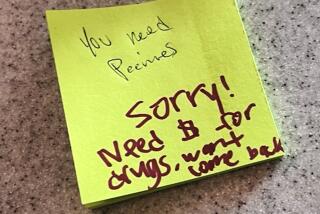Fearful Public Creates Dark Days for Japan Night Life : Terrorism: Despite arrest of cult leader, anxiety casts pall over Tokyo. More suspects are taken into custody.
TOKYO — Forget the pundits and prognosticators weighing in on the impact of Aum Supreme Truth and the doomsday cult’s alleged subway nerve gas attack. Here in the center of the naughty nightclub district of Shinjuku, Shojin Hotta’s ramshackle whiskey bar serves as a more persuasive social barometer.
Hotta’s verdict: Despite the climactic arrest Tuesday of guru Shoko Asahara on suspicion of murder in connection with the subway attack, the public unease over Japan’s most sensational criminal case has not yet let up.
His evidence: By midnight Wednesday, only 10 customers had stopped by--reflecting, he said, a huge drop in his trade from before the terrorist incident.
Police continued to move forward on the case today, nabbing the most prominent remaining suspect. Takeshi Matsumoto, 29, was arrested in Tokyo on suspicion of murder in connection with the subway case, but he is also implicated in the kidnaping of a notary public and other crimes. In addition, police made five new arrests Wednesday and reportedly extracted a first-time confession from Ikuo Hayashi, the group’s medical chief, that Asahara had directly ordered the gas attack.
The guru, who was arrested after being discovered in a hidden room in his Mt. Fuji compound, has declared his innocence and reportedly is refusing to answer even questions about his name.
In a blow to Asahara, Japan’s most famous criminal defense lawyer rejected the guru’s request to represent him after a 20-minute meeting, saying he was not convinced of his innocence.
The guru lamented, “What am I going to do without a lawyer?” according to the attorney, Makoto Endo.
As more confessions continued to leak out, the Japanese press reported that kidnaped notary public Kiyoshi Kariya died while in the cult’s custody.
Hayashi, the sect doctor, reportedly told police that he was asked to give Kariya an injection but found him dead after the group kidnaped him, beat him and pumped him with truth serum to disclose the whereabouts of his sister. The sister had left the cult after donating $60,000.
Despite the appearance of progress in the cult case, 80,000 police remained on alert. Officials urged public vigilance against several suspects still at large and against possible attacks from sarin, the nerve gas that authorities have said was used in the March subway assault. Officials fear that cult members may still have sarin stockpiled somewhere.
“We will continue our nationwide investigation. This is just the start,” said Yuko Sekiguchi, the National Police Agency’s deputy chief.
Nowhere is the continued disquiet more apparent than in Shinjuku. The district of high-rises and department stores--which is also Tokyo’s sleaziest entertainment area--suffered a double whammy to its image with a May 5 poison gas scare and a parcel bomb explosion Tuesday in the area that crippled Masaaki Utsumi, Gov. Yukio Aoshima’s executive secretary.
Most commuters can’t avoid riding the subways to work through Kasumigaseki, the federal government hub targeted in the March 20 attack.
But people can avoid the cafes and bars of Shinjuku--and they still apparently are.
At the New Tops jazz bar, Chie Ihara, 25, and Kiichi Komuro, 28, said they came to Shinjuku with some misgiving.
“When we got off the train, we wondered: ‘Will today be safe?’ ” Ihara said.
New Tops, like many of the other 60,000 eateries and bars crammed into this district, still has not recovered from a downturn in business since the March 20 attack, which killed 12 people, sickened more than 5,500 and stunned a nation that prides itself on its atmosphere of law and order.
“Until the case is resolved, things probably won’t go back to normal,” a cashier at the bar said.
Hotta, a red-cheeked, garrulous man who doubles as the Shinjuku Yotsuya Restaurant and Bar Assn. chief, said the subway attack has caused the worst slowdown he can recall.
Hotta opened his tavern in 1956, just after the government lifted price controls and allowed Japanese to operate drinking establishments.
His business, he said, peaked before the 1964 Olympics, when the 20-seat bar turned over its clientele six times a night and drew 200 people a day.
But authorities imposed a midnight drinking curfew on bars a year before and after the Olympic Games to reduce the possibility that drunken Japanese would despoil the national image, Hotta said.
It’s been downhill since, he said.
Although his business picked up during the high-flying 1990s period known as “The Bubble Era,” the lingering recession and now the subway attack have pushed it back down.
Over at the New Tops jazz bar, however, Komuro is not so sure of the lasting impact, given what pop sociologists label Japan’s “typhoon mentality”--an ability to weather a storm, sustain the destruction and move forward with few looks back.
“Once things go back to normal, we’ll forget about it,” Komuro said. “It’s our national characteristic.”
Chiaki Kitada of The Times’ Tokyo Bureau contributed to this report.
More to Read
Sign up for Essential California
The most important California stories and recommendations in your inbox every morning.
You may occasionally receive promotional content from the Los Angeles Times.











